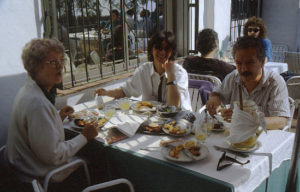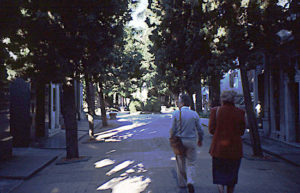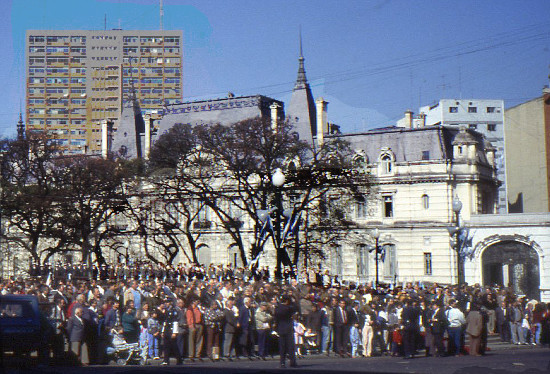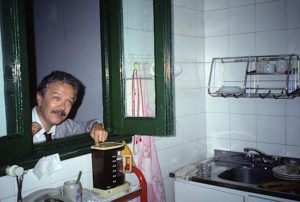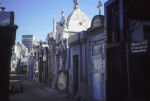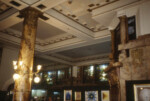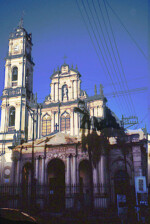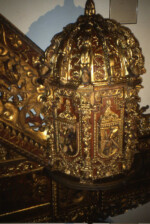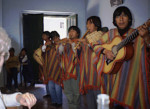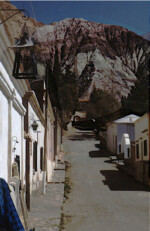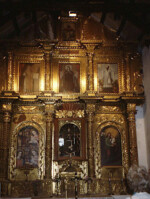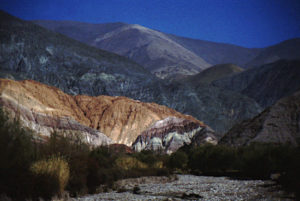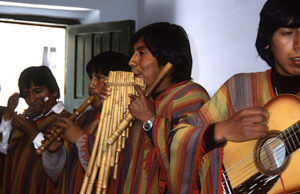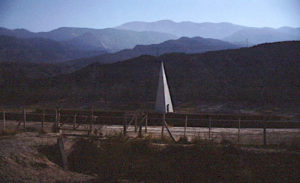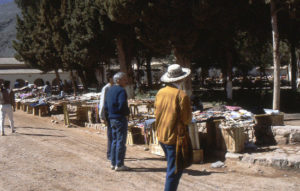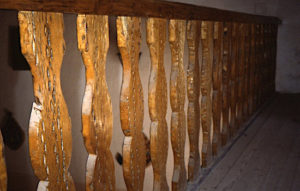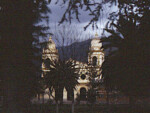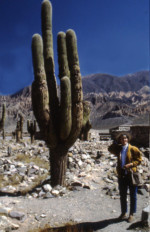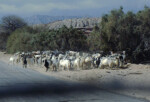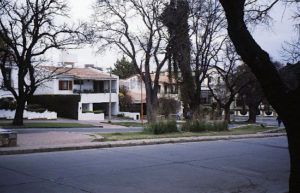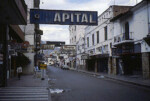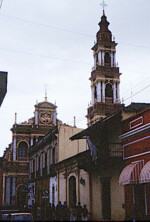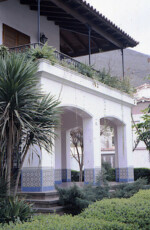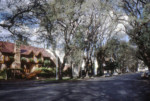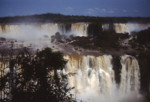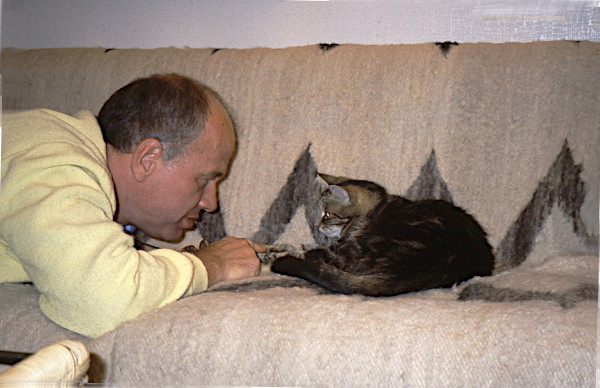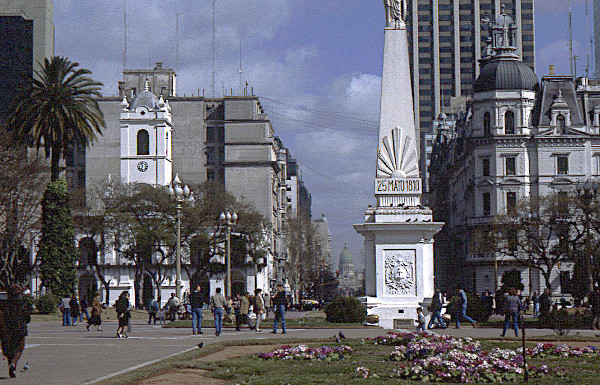
Plaza de Mayo, ‘La columna de Libertad. — Left ‘El Cabildo’, used as seat of the town concil during the colonial era.
In 1990 we had the idea of going to Buenos Aires and Argentina generally to visit our very dear friend Roberto and his partner, Marta, a psychotherapist.
Roberto had moved back to Buenos Aires in 1981, and we had a party for him at rue Caillaux with most of his and our friends. We missed him very very much. He was so often at our place that it seemed somewhat empty without him.
I suggested using some of the money I had inherited from my stepfather, Arne, who must have invested the money pretty well that he inherited from his Tante Anna via his mother, Tante Gerda.
So I took a hunk out of my dwindling Swedish bank account (the first hunk went to the building of our precious veranda in ’87). And it was a good thing too that Arne’s money came to use while it was still worth something. With the inflation that has taken place since 1986, the money would be crumbs by now.
Tante Anna was a legend. She lived to be almost a hundred and she resided in a 12-room apartment on Östermalm in Stockholm, not far from Karlaplan. She had at least two maids (but no butler) and when Mother and Arne went to visit her, a visit at a formal visiting hour, they gave their cards to the maid who opened the door, and they were subsequently asked to step into the yellow ‘salon‘, or the blue ‘salon‘ or the rose-colored ‘salon‘. Never mind which one of Tante Anna’s various ‘salons’. My mother had to be introduced to Tante Anna — it was a condition for the upcoming marriage?. The dowager must not be ignored.
Tante Anna and her since a long time defunct husband, uncle Ernst, were the couple who usually invited young Gerda to accompany them on their travels to Italy and France. Tante Anna and her sister, Tante Gerda’s mother, nicknamed Stassi, originated from Höganäs, a town in the very southernmost province of Skåne. This legendary ‘Stassi’ was much admired for her beauty, by King Oscar II among others,
A legend about ‘Stassi’ has it that young Gerda was walking on Strandvägen with her nurse one sunny day, when King Oscar happened to pass by in his carrosse. The king told his driver to stop. When he was told who the pretty girl was he said, as the legend goes, “Such a pretty girl. You will be as pretty as your mother. How well the king knew beautiful ‘Stassi’ is the object of her grandsons’ joking about this episode — the grandsons being Arne and his brother Birger.
The clearly very well-off young ladies, Anna and ‘Stassi’, married Stockholmers, Gerda’s mother, ‘Stassi’, married a very successful import businessman August Julius, whose business was the first one in Sweden to import bananas. Anna married an apothecary, which was obviously a very lucrative business in those days. His ‘apotek‘ or pharmacy was in Sundsvall, a town up north on the east coast of Sweden. How he managed to accumulate such a considerable fortune the way he did from what is called an ‘apotek‘ in Swedish, seems amazing today.
The times they are a’changing.
_________________
We arrived in Buenos Aires from Florida on a sunny day in early August and Marta’s younger son was at the airport to meet us. Wonderful. We really appreciated that.
We were installed in Marta’s nice house in downtown B.A. The very first day we went to a restaurant right on the big river, Rio de la Plata, and we had the most delicious deep-fried riz-de-veau (sweetbreads), which John and I both think is about the best meat you can get. Our days or probably a couple of weeks in Buenos Aires were filled with festivities, late nights, tango shows and cafés with delicious ingredientes — munchies, if that vague word can explain to some extent what those delicious things were..
On the first day after our arrival we went to a café in the neighborhood of Recoleta and had a very nice time with some of Marta’s and Roberto’s friends who spoke French.
We walked around with Roberto in the beautiful and huge Recoleta cemetery which has mausoleums as big as houses. I guess it is one up on Père Lachaise in Paris, even though this Paris cemetery is also much lauded for its peaceful beauty.
On our way from Recoleta we came across a very colorful scene. At Plaza de San Martin, a fiesta de San Martin was taking place. Masses of people were celebrating the Spanish General José San Martin, El Libertador of Argentina, Chile and Peru around 1814. Unending processions of people in colonial costumes, music, military and horse-drawn carts were all part of the huge celebration.
_____________________
Obviously, since Marta worked as a psychotherapist during the days she could not accompany us on our late evening sprees.
The tango shows were amazing. We had never seen real tango, even though I had actually danced some kind of tango with one-time friend Sven Heurgren, Sweden’s first, in fact the world’s first, ombudsman (consumer ombudsman in his case, but that was many years later). I was very young, and so was he, and he was really my sister Gun’s boyfriend. It seems amazing to me how, if you have a good dancer who knows how to lead, it is possible to do the most unexpected things when you dance. It is quite amazing what a hand on your back can achieve, when the man knows what he is doing.
But that was a summer on the west coast of Sweden and the year was 1949. Here we were in Buenos Aires in 1990. The tango was not quite the same kind. Only the rhythm was the same. And there was no bandoneon in Sweden.
More often than not we went out in the evenings to see tango spectacles or just to go to a nice café to have an apéritif that would always be served ed with ingredientes, that were so plentiful that you barely needed dinner afterwards. Or we would go to a tango show from the café and have a late supper in a restaurant after the show.
Tango is intoxicating. The music alone carries you away to another world, but the sensuous and graceful dancing makes you feel pure ecstasy. The styles, however, varied some, but the women always wore the heavy heeled shoes that were ‘en vogue’ in the twenties. Oh, tango — it plays on your heart strings. And of course it takes you back to an era that has by now been gone for a hundred years.
Once, an event which we will never forget, we came out from a tango show and found that the show was going on in the street. Once a week, traffic was banned from this street, known as the Broadway of BA, and people danced in the street. Quite a few couples were actually having their own little show in the street. They were good, and we were watching them for quite a while. This was seven years after the fall of the military junta. I think it is safe to say that this kind of joy could not have taken place in the streets during the seven years of the terrorist regime. The 1976 coup by Juan Perón was overthrown. He is, however, a man whom I have never managed to get a grip on. For the people, or just for himself?
_______________
Our visit to Buenos Aires was a whirlwind of tango evenings, cafés with delicious ingredientes, that always went with the drinks, restaurants, walks around the city — and what a city! We bought a few leather things that would have cost a mint in Europe and that are still in use.
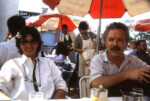
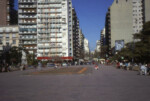


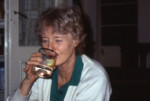
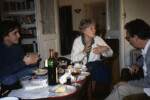



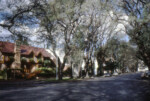


One late evening we, Roberto, John and I came back ‘home’ around midnight, and Roberto found some delicious looking looking steaks in the fridge. We fried them and yes, they were delicious. It turned out that it was the next day’s dinner we had been feasting on. But good it was. As I understand it, Marta wasn’t too upset.
Jujuy and Humauaca with Quebrada (valley) de Humahuaca


Of course we did some traveling when we were in this fascinating and extremely varied country. We first went to the northwest, close to Bolivia. I am sure that, at one time, the indigenous people wandered across that region of Argentina and into Bolivia, back and forth freely. That was before borders came in to make colonization possible.
We landed in Jujuy and picked up our rented car, a Renault 12 that had seen better days. It seemed as if practically half the cars in Argentina were old Renault 12, at least as far as we could see.
We saw a couple of interesting sights in Jujuy, mainly the beautiful interior of the cathedral with lots of gold decorations. Jujuy is the capital of Jujuy province, so cathedral it was, and the city is very close to the border of Bolivia. Some palace-like buildings also reminded visitors of the colonial past of Argentina and of course the rest of Latin America
Our most vivid memories from this week-long stay in Jujuy are the two trips we made north, first to Humahuaca, which was unforgettable and the second one to a couple of other villages
and incredibly beautiful sights along the road. Tilcara, Purmamarca and the archeological site, Pucará de Tilcara, which also offered a view of possibly one thousand cactuses. Pucará de Tilcara, is a pre-Inca fortification — from the 10th century. On the way to Humahuaca we turned into a little cove where a sign said “Cerro de las siege colores”. (Cerro – hill). But that place was just one of the masses of grandiose mountain sights that looked like they were taken out of an exotic art book. The colors were astounding. I seriously believe that there is no other mountain region on this planet that can present the wealth of incredibly varying colors as this region of the low Andes in northern Argentina and Bolivia.
Humahuaca is at an altitude of 3500m. located in a valley (quebrada) between mountains that are both wonderfully colorful and also offer spectacular erosions, reminiscent of Monument Valley in south Utah, very close to Arizona.1
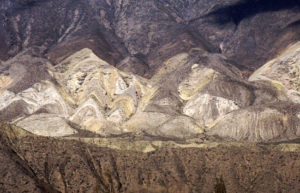
What modern painter might have painted this masterpiece! Billions of years of evolution. Quebrada de Humahuaca
Given the altitude, I right away bought a hat to protect my head from the sun. The hat is also still with us today.
The most memorable event in Humahuaca was lunch-dinner in a restaurant where nobody spoke anything but Spanish, the same as at the market where we bought several wonderful things, jackets, a ruana (like a poncho, but open in the front, for women), which I still today often put over my shoulders when I am chilled.
But back to our meal at the restaurant. We sat down at a table, the only tourists, as far as I could see. A little boy, about ten or so, came up and looked as if he wanted to take our order So I said we wanted to eat and he walked away. We expected something to happen, but nothing did.
After a while we realized that nothing was going to be done unless I took the matter in my own hands. I walked into the kitchen and found that there was a line of customers, all waiting to be served some stew from a huge pot. Most certainly a beef stew. I was served two plates of stew when it got to be my turn, and everybody appeared to find this the proper way of getting served.
All was well, the beef stew was good, and probably so was the wine. But the big surprise was a group of musicians, Inca looking, who came into the restaurant with their instruments. We were as delighted as we were surprised and we realized that we had hit on the right restaurant.
Of course they got their reward for the performance, and I do think the rest of the customers also made a contribution.
The market was quite fantastic. The beautiful things they sold and the lively bargaining and general ambiance were so foreign to us that we definitely realized that we were in a different world from Europe and eastern U.S. Colorful fabrics made from llama wool or, even more precious, from alpaca, a smaller cousin of the llama. If I remember correctly, my ruana is alpaca wool, which is a finer fibre than the llama, pronounced ‘yama’. The merchandise was so inexpensive that it was almost embarrassing. We had not yet been either in India or in Morocco and this kind of market was all new to us. Well, apart from some a bit similar things we had seen in the southwest of the U.S., Santa Fe, which is not at all up to this level of variety and quality of merchandise. The abundance here of rich high-quality clothing was something we had never encountered, before or later.
There were no modern looking or European looking houses in Humahuaca. None. What the walls were made of I am not expert enough to say, but it may have been adobe. We definitely saw adobe houses alongside the road on the way back to Jujuy.
We also took a picture of the pyramid of the Tropic of Capricorn on our way back. Yes, we were indeed far south of the Equator. One late evening in Jujuy a friendly waiter took us out on the roof during dinner to show us the Southern cross. He was certainly used to northern tourists who got a big charge out of seeing this constellation for the first time. It is however remarkable how people in the warm climates are so very friendly and of course lively. I have a theory about this, but I will spare my readers. In France it’s just Hurry hurry hurry.(Vite vite vie)
Our second day trip north from Jujuy was to see Tilcara and Purmamarca with all the beautiful mountains. We also had planned a visit to the archeological site, the pre-Inca fortification, Pucará de Tilcara. We had one more very interesting day, even though there were no Inca-style musicians this time.
There was, however, another very interesting market in Purmamarca and of course we fell for something. We bought what I believe was a ‘blanket’ or a cover of some kind. Or, more exactly, this ‘blanket’ a piece of heavy llama wool was most likely made to sit on in an adobe hut where there were no chairs.
To get that huge and heavy ‘blanket’ back to France, we had to buy another suitcase in Buenos Aires, or might it have been in Salta? I remember looking up ‘wheel’ in my Spanish dictionary so we could explain that we wanted ‘una maleta con ruedas‘. Rueda was not a word in my limited Spanish vocabulary.
Among all the various things that amazed us on this unforgettable trip were the size and the humongous numbers of cactuses. They were huge and ubiquitous. Also we had never known that houses can be built with cactus wood. Most of the wood inside Purmamarca church was indeed cactus wood.
________________
Tilcara and the quebrada de Cafayate
After a fascinating drive from Jujuy to Salta, we arrived in this second provincial capital where we spent another couple of days. On the road we had several interesting surprises. The jungle, the desert, the eroded rock formations, indeed reminiscent of Monument Valley in south Utah. The jungle was something totally new, to me at least. And even the Everglades in Florida are not the same.
In The southwest of the United States in 1979, there had been nothing like the powerful and foreign ambiance of indigenous culture — the lively and exotic charm of the people, noise and movement never ceasing. Also the mountains are more spectacular than anything we had seen before.
Between walks and museums of local culture, we had the most wonderful experience. We were on our way back from a walk in the western posh area of Salta when we saw… Hey! a restaurant that looked very interesting. It was called ‘Tio Jack‘ — Uncle Jack. We put our heads in the door and asked if there was a table for us. No way. They told us to come back in the evening and they would reserve a table for us. Which we did.
The food was even better than we could ever have expected and the atmosphere was impossible to describe. You had to be there. Obviously we had beef. And what a steak. What else do you eat in an Argentinian restaurant like this one, far away from the cosmopolitan decadence. I said in my Spanish that I thought was (this time) very clear that we would like to share one piece of beef. We had seen the size of the portions. Luckily the waiter completely ignored me. Or was it Tio Jack himself? It could well have been. When the plates arrived, we found that they had given each one of us a giant piece of beef. I have never had beef like that, and I never will again. Of course we ate it all. Unforgettable.
Salta — a couple of days’ visit
From Salta we caught the plane back to Buenos Aires. The same day, after lunch with Roberto at the airport, we connected to a flight from BA to Brazil where we were going to see the fabulously powerful Iguazu waterfalls on the border between Argentina and Brazil. We spent a night in a nice hotel on the Brazilian side that was clearly there just for visitors to the falls. These enormously spread out falls, and also enormously high, are so impressive it is hard to describe. They have to be seen.2
Just seeing these wild cascades was well worth the trip. I lived fairly close to Niagara and drove quite close by a couple of times, but I never saw it. However, these falls far outdo Niagara, even though the Niagara water is most likely cleaner.
Then back to Buenos Aires where we spent quite a few more days with Marta and Roberto. More cafés with apéritifs and ingredientes and wonderful tango. A fabulous and memorable visit.
Continued: Chapter 36 (Part 1) — Adventures in the Austrian Alps
- Curiosité géologique, le Cerro de los Siete Colores (« colline aux sept couleurs ») est le nom donné à un flanc de montagne, situé dans les Andes dans le petit village indien de Purmamarcadans la province de Jujuy en Argentine. La gamme de couleurs s’étend du beige au violet, en passant par du vert. Le Cerro de los Siete Colores , la Serranía de Hornocal, de même que la Paleta del Pintor (la Palette du peintre) à Maimará, sont les trois sites les plus caractéristiques de la symphonie de couleurs qui pare la Quebrada de Humahuaca. ↩
- Cataratas do Iguaçu are waterfalls of the Iguazu River on the border of the Argentine province of Misiones and the Brazilian state of Paraná. Together, they make up the largest waterfall in the world. ↩


